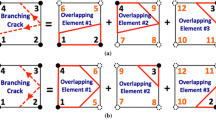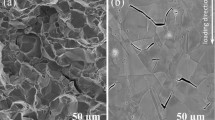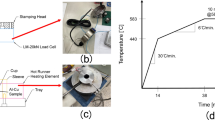Abstract
Local failure initiation mechanisms, such as the nucleation and propagation of multiple cracks, have been investigated in energetic aggregates with a viscoelastic estane binder and crystalline RDX grains that have been subjected to dynamic thermo-mechanical loading conditions. A dislocation density-based crystalline plasticity, finite viscoelasticity, dynamic fracture nucleation and propagation, and non-linear finite-element formulations were used to study crack nucleation and propagation due to dynamic, tensile mechanical strain-rate loading conditions in RDX-Estane energetic aggregates. The interrelated effects of grain boundary (GB) misorientations, porosity, grain morphology, dislocation densities, polymer binder relaxation, and crystal-binder interactions were coupled with adiabatic plasticity heating, thermal decomposition, and viscous dissipation heating to fundamentally understand and predict aggregate behavior and local failure initiation mechanisms. The predictions indicate that local failure occurs when cracks nucleate at the peripheries of internal porosity and subsequently propagate toward the viscoelastic estane binder where crack arrest occurs at the interface, which results in large inelastic deformations and temperature accumulations at the interfaces.











Similar content being viewed by others
References
Walley S, Field J, Greenaway M (2006) Crystal sensitivities of energetic materials. Mater Sci Technol 22:402–413
Armstrong R, Elban W (2006) Materials science and technology aspects of energetic (explosive) materials. Mater Sci Technol 22:381–395
Baer M (2002) Modeling heterogeneous energetic materials at the mesoscale. Thermochim Acta 384:351–367
Borne L (1993) Influence of Intragranular cavities of RDX particale batches on the sensitivity of cast wax bonded explosives. In: 10th Symposium on Detonation, 33395–33412
Borne L, Mory J, Schlesser F (2008) Reduced Sensitivity RDX (RS-RDX) in pressed formulations: respective effects of intra-granular pores, extra-granular pores and pore sizes. Propellants Explos Pyrotech 33:37–43
Bruckman H, Guillet J (1968) Theoretical calculations of hot-spot initiation in explosives. Can J Chem 46:3221–3228
Cardao P, Gois J, Campos J (2000) Thermal decomposition of energetic materials. AIP Conf Proc 505:853–856
Field J, Bourne N, Palmer S, Walley S, Sharma J, Beard B (1992) Hot-spot ignition mechanisms for explosives and propellants [and Discussion]. Philos Trans R Soc Lond Ser A 339:269–283
Armstrong R, Coffey C, DeVost V, Elban W (1990) Crystal size dependence for impact initiation of cyclotrimethylenetrinitramine explosive. J Appl Phys 68:979–984
Borne L, Patedoye J, Spyckerelle C (1999) Quantitative characterization of internal defects in RDX crystals. Propellants Explos Pyrotech 24:255–259
Czerski H, Proud W (2007) Relationship between the morphology of granular cyclotrimethylene-trinitramine and its shock sensitivity. J Appl Phys 102:113–115
Hooks D, Ramos K, Bahr D (2007) The effect of cracks and voids on the dynamic yield of Rdx single crystals. AIP Conf Proc 955:789–794
Qiu H, Stepanov V, Di Stasio A, Chou T, Lee W (2011) RDX-based nanocomposite microparticles for significantly reduced shock sensitivity. J Hazard Mater 185:489–493
Bouma R, Duvalois W, Heijden A (2013) Microscopic characterization of defect structure in RDX crystals. J Microsc 252:263–274
Bouma RHB, van der Heijden AEDM, Sewell TD, Thompson DL (2011) Simulations of deformation processes in energetic materials. In: Awrejcewicz J (ed) Numerical simulations of physical and engineering processes. http://www.intechopen.com/books/numerical-simulations-of-physical-and-engineering-processes/simulationsof-deformationprocesses-in-energetic-materials
Palmer S, Field J (1982) The Deformation and Fracture of beta-HMX. Proc R Soc Lond 383:399–407
Sharma J, Armstrong R, Elban W, Coffey C, Sandusky H (2001) Nanofractography of shocked RDX explosive crystals with atomic force microscopy. Appl Phys Lett 78:457–459
Smith D, Thorpe B (1973) Fracture in the high explosive RDX/TNT. J Mater Sci 8:757–759
Wang Y, Li J, Hamza A, Barbee T (2007) Ductile crystalline-amorphous nanolaminates. Proc Natl Acad Sci USA 104:11155–11160
Zhang J, Liu G, Sun J (2014) Self-toughening crystalline Cu/amorphous Cu–Zr nanolaminates: deformation-induced devitrification. Acta Mater 66:22–31
Voevodin A, Zabinski J (1998) Load-adaptive crystalline–amorphous nanocomposites. J Mater Sci 33:319–327
Shanthraj P, Zikry M (2011) Dislocation density evolution and interactions in crystalline materials. Acta Mater 59:7695–7702
Zikry M (1994) An accurate and stable algorithm for high strain-rate finite strain plasticity. Comput Struct 50:337–350
Ashmawi W, Zikry M (2002) Prediction of grain-boundary interfacial mechanisms in polycrystalline materials. J Eng Mater Technol 124:88–96
Shanthraj P, Zikry M (2012) Dislocation-density mechanisms for void interactions in crystalline materials. Int J Plast 34:154–163
Hutchinson J (1976) Bounds and self-consistent estimates for creep of polycrystalline materials. Proc R Soc Lond 348:101–127
Pan J, Rice J (1983) Rate sensitivity of plastic flow and implications for yield-surface vertices. Int J Solids Struct 19:973–987
Franciosi P, Berveiller M, Zaoui A (1980) Latent hardening in copper and aluminium single crystals. Acta Metall 28:273–283
Devincre B, Hoc T, Kubin L (2008) Dislocation mean free paths and strain hardening of crystals. Science 320:1745–1748
Zikry M, Kao M (1996) Dislocation based multiple-slip crystalline constitutive formulation for finite-strain plasticity. Scr Mater 34:1115–1121
Kaliske M, Rothert H (1997) Formulation and implementation of three-dimensional viscoelasticity at small and finite strains. Comput Mech 19:228–239
Mas E, Clements B, Blumenthal B et al (2002) A viscoelastic model for PBX binder. AIP Conf Proc 620:661–664
Kendall M, Siviour C (2014) Rate dependence of poly (vinyl chloride), the effects of plasticizer and time–temperature superposition. Proc Royal Soc A 470:2167–2182
Antolovich S, Armstrong R (2014) Plastic strain localization in metals: origins and consequences. Prog Mater Sci 59:1–160
Johnson A, Chen T (2005) Approximating thermo-viscoelastic heating of largely strained solid rubber components. Comput Methods Appl Mech Eng 194:313–325
Shanthraj P, Zikry M (2013) Microstructurally induced fracture nucleation and propagation in martensitic steel. J Mech Phys Solids 61:1091–1105
Hansbo A, Hansbo P (2004) A finite element method for the simulation of strong and weak discontinuities in solid mechanics. Comput Methods Appl Mech Eng 193:3523–3540
Song J, Areias P, Belytschko T (2006) A method for dynamic crack and shear band propagation with phantom nodes. Int J Numer Methods Eng 67:868–893
Hooks D, Ramos K, Martinez A (2006) Elastic-plastic shock wave profiles in oriented single crystals of cyclotrimethylene trinitramine (RDX) at 2.25 GPa. J Appl Phys 100:024908–024917
Gallagher H, Halfpenny P, Miller J et al (1992) Dislocation slip systems in pentaerythritol tetranitrate (PETN) and cyclotrimethylene trinitramine (RDX). Philos Trans 339:293–303
Annapragada S, Sun D, Garimella S (2007) Prediction of effective thermo-mechanical properties of particulate composites. Comput Mater Sci 40:255–266
Barua A, Zhou M (2011) A Lagrangian framework for analyzing microstructural level response of polymer-bonded explosives. Model Simul Mater Sci Eng 19:055001
Stoltz C, Mason B, Hooper J (2010) Neutron scattering study of internal void structure in RDX. J Appl Phys 107:103527–103534
LaBarbera D, Zikry M (2013) The effects of microstructural defects on hot spot formation in cyclotrimethylenetrinitramine-polychlorotrifluoroethylene energetic aggregates. J Appl Phys 113:243502–243514
Acknowledgements
This material is based upon work supported by the U.S. Office of Naval Research as a Multi-Disciplinary University Research Initiative on Sound and Electromagnetic Interacting Waves under Grant Number N00014-10-1-0958.
Author information
Authors and Affiliations
Corresponding author
Rights and permissions
About this article
Cite this article
LaBarbera, D.A., Zikry, M.A. Dynamic fracture and local failure mechanisms in heterogeneous RDX-Estane energetic aggregates. J Mater Sci 50, 5549–5561 (2015). https://doi.org/10.1007/s10853-015-9102-1
Received:
Accepted:
Published:
Issue Date:
DOI: https://doi.org/10.1007/s10853-015-9102-1




